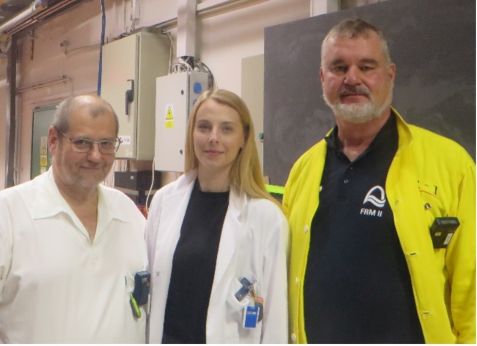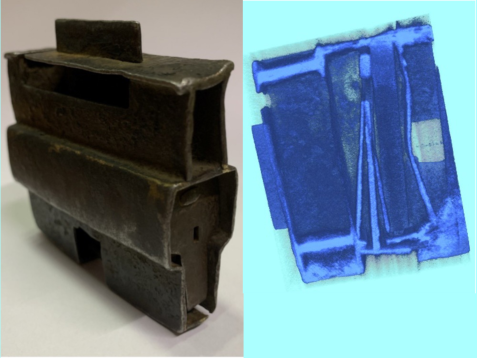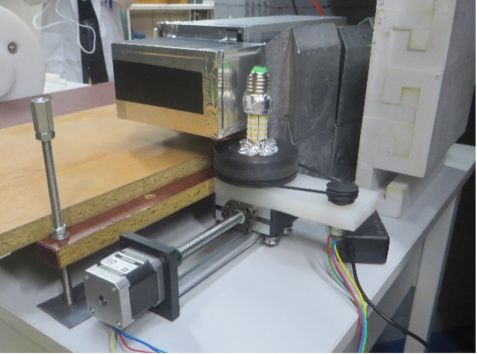MLZ is a cooperation between:
 > Technische Universität München
> Technische Universität München > Helmholtz-Zentrum Hereon
> Helmholtz-Zentrum Hereon
 > Forschungszentrum Jülich
> Forschungszentrum Jülich
MLZ is a member of:
 > LENS
> LENS > ERF-AISBL
> ERF-AISBL
MLZ on social media:

MLZ (eng)
Lichtenbergstr.1
85748 Garching
18.01.2022
Neutron imaging detector in handbag size
The Covid-19 pandemic has not been making things easy for researchers either. But a scientist from the Heinz Maier-Leibnitz Zentrum (MLZ) and a doctoral student at the training reactor in Prague did not let lockdowns and travel restrictions get them down: Using video calls, they teamed up to build a portable, highly sensitive neutron detector.
“I really didn’t expect it to work so well,” admits Dr Burkhard Schillinger, instrument scientist at the ANTARES neutron radiography facility at the Heinz Maier-Leibnitz Research Neutron Source (FRM II). With his help, Jana Matoušková, a doctoral student at the VR-1 training reactor at the Czech Technical University (CTU) in Prague, replicated a sensitive neutron detector he had previously developed at FRM II, which produces usable images with only 500 W of reactor power. By comparison, the FRM II runs at a power of 20 MW – that’s 40,000 times as much.

Personal meeting after the end of the lockdown: Dr. Burkhard Schillinger (right) with Jana Matoušková (middle) and Dr. Lubomir Sklenka (left) at the training reactor VR-1 in Prague. © Burkhard Schillinger
Instructions via Zoom
What makes the researchers’ success even more impressive is the fact that the joint project could initially only take place via video phone calls. Schillinger explained via Zoom and Matoušková followed his instructions from her desk at home. “Jana Matoušková was supplied with the necessary mechanical parts by the workshop and then assembled the neutron detector with control system including software completely on her own at her home office,” says Schillinger. “She even learned how to solder by video.”
Portable, sensitive and cheap
In the end, the result was a portable neutron detector that could be used at any neutron source. The detector gets its high sensitivity from the built-in astronomy camera. Such cameras for amateur astronomers are getting cheaper and cheaper. The complete detector thus only cost around €1000, many thousands of euros less than the usual neutron detectors at the FRM II.

Left: photo of the padlock, right: The 3D reconstruction from the measurements of the detector of a Tibetan padlock (The shackle of the lock is not in the image). © links: Jana Matoušková, rechts: Burkhard Schillinger
Due to its high sensitivity, the detector also delivers images at reactors with very low power, such as the VR-1 near-zero reactor – but with certain limitations. Matoušková needed twelve hours for her world’s first neutron tomography at 500 watts. “For cutting-edge research, a high-power reactor like the FRM II remains indispensable,” explains Schillinger, “but it was impressive to see that we could take an image at all at such low power.” Mathematically, the same image could be taken at FRM II within a few seconds. But since ANTARES records about a hundred times more neutrons and more angular positions for a detailed and noise-free 3-D-image, researchers would only need about half an hour for this.
Detector is a mini version of ANTARES
The detector Jana Matoušková built with the help of Burkhard Schillinger is a scaled-down copy of the neutron radiography system at FRM II. “Put simply, with the help of neutrons you can often see everything that is not visible with X-rays,” says Schillinger, explaining the principle of neutron radiography and tomography, which is operated at the MLZ on the ANTARES and NECTAR instruments. The video on the right explains exactly how it works.
And Jana Matoušková showed that it really does work in handbag format with her first tomography of a Tibetan padlock. “I was really surprised how well you could make out details despite the somewhat noisy images,” admits Burkhard Schillinger.
MLZ is a cooperation between:
 > Technische Universität München
> Technische Universität München > Helmholtz-Zentrum Hereon
> Helmholtz-Zentrum Hereon
 > Forschungszentrum Jülich
> Forschungszentrum Jülich
MLZ is a member of:
 > LENS
> LENS > ERF-AISBL
> ERF-AISBL
MLZ on social media:



